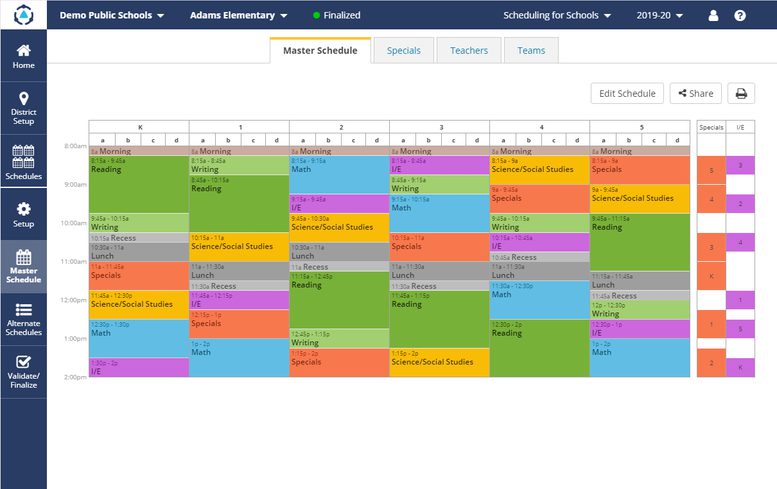This 12-part How to Build an Elementary School Schedule series shares expert step-by-step guidance and proven scheduling strategies to help you create better schedules this year.
After scheduling specials, the next step in building your elementary school schedule is to add lunch and recess. Scheduling lunch and recess can be more complex than it might seem, as there are a number of considerations to be taken into account, including timing, duration, and lunch and playground capacity.
Here are some key questions you should think about before you begin scheduling lunch and recess.
- What is the right amount of time for lunch?
- Should lunch and recess be scheduled back-to-back or split up and scheduled separately at different parts of the day?
- Should recess take place before or after lunch?
- How many waves are needed and which grades should be combined?
The USDA does not specify a recommended amount of time for lunch, so it is left to districts and schools to determine while balancing the requirements of the curriculum. According to the School Nutrition Association's State of School Nutrition 2018 survey, which included responses from 1,550 school districts nationwide, the typical lunch period length is about half an hour, with a median of 25 minutes reported for elementary schools.
These averages align with research that indicates students need a minimum of 20 minutes in their seats to eat. This excludes time waiting in line, using the bathroom, or other transition activities. When thinking about how much time your students need, start at 20 minutes and then add time for transition activities (e.g. 20 minutes eating time + 2-minute walk to cafeteria + 3 minutes in lunch line = 25 minute lunch period).
Adequate time helps ensure that students get the nutrition they need to grow and learn while wasting less food. If your school has a higher level of students receiving free and reduced lunch, consider how lunch lines will impact their seat time. For many students in poverty, the school breakfast and lunch will be the most nutritious or only meals of the day.
Scheduling lunch and recess consecutively has several advantages. First, doing so allows you to stagger lunch during the same lunch/recess window without disrupting your grade-level core instruction time, which can provide teachers with time for common planning or collaboration in other ways. In addition, scheduling lunch and recess consecutively reduces transition time, thereby limiting fragmentation and interruptions during instructional windows. Finally, scheduling lunch and recess adjacent to one another will align more staff to support lunch and recess duties.
Depending on the age and developmental stage of students, creating a short snack and movement break time can be important. These may be good alternatives to shifting lunch and recess blocks. Consider how these will be leveraged in conjunction with lunch and recess blocks to help your students learn.
There is no wrong answer here. What makes sense for your building should take into consideration your students, climate, and other factors that vary from school to school and region to region. The physical spaces available for lunch and recess will also influence your decision.
However, there is some research that shows there are benefits tied to the scheduling sequence of lunch and recess; scheduling recess before lunch results in students eating more and healthier food than when recess is scheduled after lunch. Starting with recess helps students build up their appetites and reduces the occurrence of students rushing through lunch to get to recess.
If you can’t make this happen for all grades each year, can you alternate lunch and recess waves to see how your students respond in some grades?
When it comes to scheduling lunch waves, each school must work within the capacity constraints of its own cafeteria. Begin by identifying your cafeteria student capacity, and on average, how many classrooms safely fit into the cafeteria at the same time.
Next, you’ll need to identify your lunch window constraints. When can lunch start? Are there other classes (e.g. PE, Music) that use the same space as your cafeteria (e.g. the “cafetorium”)? How much time is needed to make a multipurpose room ready to serve lunch or clean up after lunch?
How much time do you need between lunch waves for students to transition to the cafeteria and make it through lunch lines while other students are leaving the lunchroom? Consider staggering start times for grades or sections by a few minutes in order to reduce the lunch line wait time.
Finally, consider any guidelines your school or district has for which grades can have lunch or recess together. Some schools prefer combining oldest and youngest grades (e.g. 1 and 5) while others schedule adjacent grades (4 and 5) to manage discipline issues.
In some cases, the above considerations may be dictated by contracts with food service providers. Consider your goals and constraints to determine what works best for your students while fitting into the confines of your schedules.

About DMSchedules
Create Better School and Staff Schedules Now with DMGroup’s DMSchedules Scheduling Software
Learn moreElementary Scheduling Software

